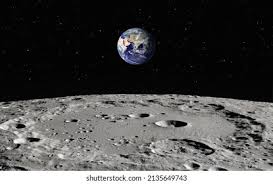
The lunar environment is one of the most mysterious and intriguing places in our solar system. As humanity gears up for future exploration and potential colonization of the Moon, understanding its environment is critical. This article provides an in-depth look at the various aspects of the lunar environment, including its atmosphere, surface, temperature, radiation, and challenges for human survival.
The Moon’s Atmosphere: A Near-Vacuum
The Moon has an incredibly thin atmosphere known as an exosphere, which is almost a vacuum compared to Earth’s atmosphere. Unlike Earth’s dense and life-supporting atmosphere, the lunar exosphere contains trace amounts of elements like helium, neon, hydrogen, and argon. These gases do not form a protective blanket around the Moon, which means there is no air pressure or breathable oxygen.The lack of a significant atmosphere means that:No weather patterns exist on the Moon.Extreme temperature fluctuations occur between day and night.No protection from solar radiation or micrometeoroid impacts is available.
Surface Composition: Regolith and Craters
The surface of the Moon is covered in a layer of fine dust and broken rock, called regolith. This regolith is formed by the constant bombardment of meteoroids and the absence of erosion processes like wind or water. The regolith varies in depth depending on the location, with the maria (large dark plains) having thinner layers than the highlands.
Key features of the lunar surface include:Craters, caused by asteroid and comet impacts over billions of years.Maria, the vast, dark plains created by ancient volcanic activity.Rilles, channels on the surface likely formed by flowing lava.Mountains and valleys, similar to Earth but formed by tectonic and impact processes.
Temperature Extremes: From Scorching Heat to Freezing Cold
One of the most challenging aspects of the lunar environment is its temperature. Due to the lack of an atmosphere, temperatures on the Moon can swing drastically from extreme heat during the day to freezing cold at night.During the lunar day, temperatures can reach up to 127°C (260°F).During the lunar night, temperatures can plummet to -173°C (-280°F).The long lunar day (about 14 Earth days) and equally long night pose significant challenges for both equipment and human explorers, as they must withstand prolonged periods of extreme conditions.
Radiation Exposure: No Shield from Space
The absence of a magnetic field and a substantial atmosphere leaves the Moon vulnerable to high levels of space radiation. This radiation primarily comes from two sources:Solar radiation, which includes harmful ultraviolet (UV) rays.Cosmic rays, high-energy particles that originate from outside the solar system.Exposure to these forms of radiation is dangerous for humans and can damage electronic equipment. Protecting astronauts and future lunar habitats from radiation is one of the primary challenges for space agencies.
Low Gravity: 1/6th of Earth’s Gravity
The gravitational pull on the Moon is only about one-sixth of that on Earth. This lower gravity has several effects on the environment and potential human activity:Objects weigh much less, which means that astronauts can jump higher and carry heavier loads.Long-term exposure to low gravity can lead to muscle atrophy and bone density loss, posing health risks for human explorers.Low gravity also affects the behavior of liquids and gases, influencing the design of habitats and life support systems.
Water on the Moon: Frozen and Hidden
Recent discoveries have confirmed the presence of water ice in permanently shadowed craters at the lunar poles. This discovery is crucial for future lunar missions, as water is essential for life and can be broken down into oxygen for breathing and hydrogen for fuel.However, accessing this water is challenging due to its location in the Moon’s coldest regions, where temperatures are consistently below freezing. Future missions will need advanced technology to mine, process, and utilize this frozen water.
Dust Hazards: The Challenge of Lunar Regolith
Lunar dust, or regolith, presents another challenge for human exploration. The dust is extremely fine, abrasive, and electrostatically charged, which means it sticks to everything, including spacesuits and equipment. Prolonged exposure to lunar dust could:Damage equipment by wearing down mechanical parts.
Pose health risks to astronauts if inhaled, potentially leading to respiratory issues.Affect visibility during landings or take-offs, as the dust is easily disturbed and creates plumes that linger due to the low gravity.
Challenges for Human Survival: Overcoming Lunar Conditions
Establishing a human presence on the Moon requires overcoming several environmental challenges. These include:Protection from radiation, which may require habitats to be built underground or shielded with thick walls.Temperature regulation, to prevent equipment from overheating during the day or freezing at night.Life support systems, including air and water recycling, as the Moon has no resources to support life directly. Energy generation, as solar power is less effective during the two-week-long lunar night, which means alternative energy sources, such as nuclear power, may be necessary.9. Future Lunar Exploration: Gateway to Deep Space .The Moon serves as a proving ground for future space exploration. NASA’s Artemis program, along with other international space agencies and private companies, aims to return humans to the Moon and establish a sustainable presence. This will lay the foundation for future missions to Mars and beyond. Understanding and mitigating the environmental challenges on the Moon will be critical for the success of these long-term exploration goals.
The lunar environment, while hostile, offers valuable opportunities for scientific discovery and the potential for human colonization. With extreme temperatures, radiation, and low gravity, it presents unique challenges that require innovative solutions. As humanity prepares for its next steps on the Moon, the lessons learned from overcoming its environment will be crucial in advancing space exploration to even greater heights.
Subscribe to Follow Global Trends for daily global news.
Find Out How To Make Money As A Full Time Writer/Blogger Guide.
To Advertise, Advertise Your Affiliate Links on FollowGlobalTrends.com for Just $1 Per Link Per Month!
Related Articles
Sustainable building materials
Written By: Enyoghasi Ngozi pricillia
,

